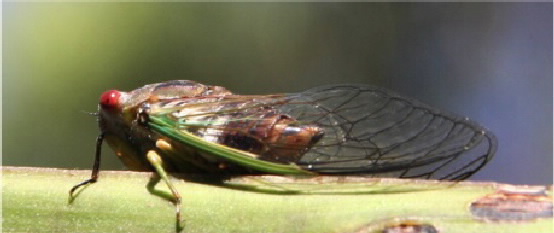Media Releases
Cicada wings tear bacteria to pieces

Cicada wings tear bacteria to pieces
James Cook University researchers and collaborators have found the wing of the cicada kills bacteria solely through its physical structure — one of the first natural surfaces found to do so.
Their work has recently been published in Nature News and Scientific American.
Dr Gregory Watson, from JCU’s Scanning Probe Microscopy Facility in the School of Marine and Tropical Biology, provided the genesis of the research along with his wife, Dr Jolanta Watson.
They were part of an international team of researchers that has come up with a detailed model of how this anti-microbial defence works on the nanoscale.
Dr Gregory Watson said cicadas, and the insect world in general, had proved fascinating.
“Being nanoscientists and biophysicists, we have been interested in the natural world of the very, very small from the start,” he said.
Their interest in cicadas was sparked more than a decade ago when they spotted a dead cicada on a bush pathway and noticed that its wings did not reflect light.
“While collecting more cicadas for study, we’d noticed that the wings of dead insects were not consumed or contaminated in the same manner as their bodies,” Dr Watson said.
“As bacteria play such an important role in decomposition, we thought there may be something responsible for this effect. As well, when we examined them with an atomic force microscope we measured very little adhesion between the cicada wings and natural contaminants such as soil fragments and pollens
“This combination, as well as intuition, provided the reasons for the studies of bacterial interactions with not only the cicada wings but also other insect wings.”
Collaborating with a microbiologist, they investigated how the nano-structures of the cicada wing interacted with some bacteria.
The group of international researchers found the wings tear the bacteria membrane apart.
“Resistance to antibiotics is a world-wide challenge as a result of the serious implications for public health. Natural biological surfaces such as insect wings gives us an exciting opportunity for templates that we can use in the development of a wide range of novel antibacterial materials for industrial and especially biomedical applications,” Dr Watson said.
The researchers recently succeeded in growing human retinal cells on cicada wings.
“This highlights the applications for these types of surfaces where we can kill bacteria but also have a surface which allows human and animal cells to grow. Such surfaces may find applications in human implants where there is a need to minimise post-surgery infections and promote wound healing,” he said.
The report in Nature News can be found at http://www.n ature.com/news/insect-wings-shred-bacteria-to-pieces-1.12533
Issued: March 26, 2013